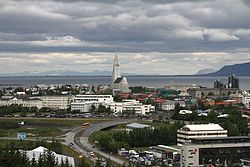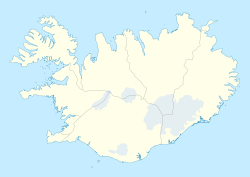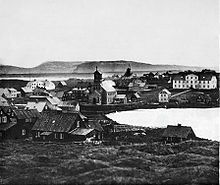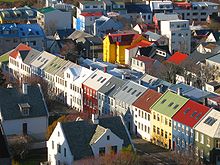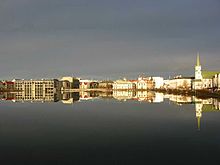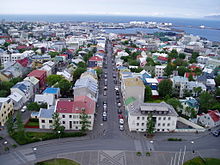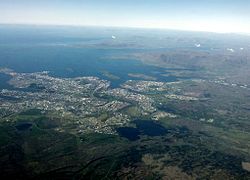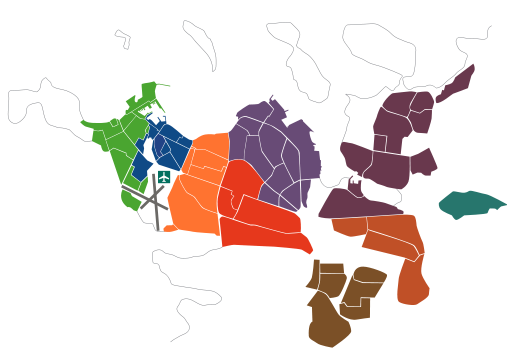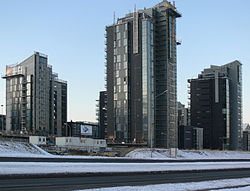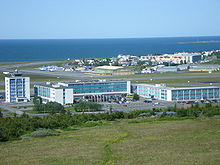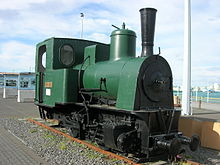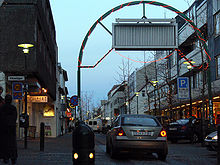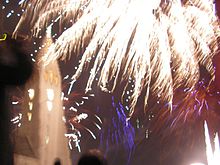
Reykjavík
Background Information
This wikipedia selection has been chosen by volunteers helping SOS Children from Wikipedia for this Wikipedia Selection for schools. Do you want to know about sponsoring? See www.sponsorachild.org.uk
| Reykjavík Reykjavíkurborg |
|||
|---|---|---|---|
| — City and Municipality — | |||
| View of Reykjavik from the top of Perlan showing the spire of Hallgrímskirkja (photograph July 2011) | |||
|
|||
|
|
|||
| Coordinates: 64°08′N 21°56′W | |||
| Country | |||
| Constituency | Reykjavík North Reykjavík South |
||
| Government | |||
| • Mayor (Borgarstjóri) | Jón Gnarr | ||
| Area | |||
| • City and Municipality | 274.5 km2 (106 sq mi) | ||
| • Metro | 777 km2 (300 sq mi) | ||
| Population (2011) | |||
| • City and Municipality | 119,108 | ||
| • Density | 436.5/km2 (1,131/sq mi) | ||
| • Metro | 202,341 | ||
| • Metro density | 259.4/km2 (672/sq mi) | ||
| Time zone | GMT ( UTC+0) | ||
| Postal code | 101-155 | ||
| Website | http://www.rvk.is/ | ||
Reykjavík (Icelandic pronunciation: [ˈreiːcaˌviːk]) is the capital and largest city in Iceland. Its latitude, at 64°08' N, makes it the world's northernmost capital of a sovereign state. It is located in southwestern Iceland, on the southern shore of Faxaflói Bay. With a population of around 120,000 (and over 200,000 in the Greater Reykjavík Area), it is the heart of Iceland's economic and governmental activity.
Reykjavík is believed to be the location of the first permanent settlement in Iceland, which Ingólfur Arnarson is said to have established around 870 C.E. Until the 18th century, there was no urban development in the city location. The city was founded in 1786 as an official trading town and grew steadily over the next decades, as it transformed into a regional and later national centre of commerce, population, and governmental activities.
History
The first permanent settlement in Iceland by Norsemen is believed to have been established in Reykjavík by Ingólfur Arnarson around AD 870; this is described in Landnámabók, or the Book of Settlement. Ingólfur Arnarson is said to have decided the location of his settlement using a traditional Viking method; by casting his high seat pillars (Öndvegissúlur) into the ocean when he saw the coastline, then settled where the pillars came to shore. Steam from hot springs in the region is said to have inspired Reykjavík's name, which loosely translates to Smoke Cove (the city is often referred to as the Bay of Smokes or Bay of Smoke) The original name was Reykjarvík with an additional "r" that vanished around 1300.
Reykjavík is not mentioned in any medieval sources except as a regular farm land but the 18th century saw the beginning of urban concentration there. The Danish rulers of Iceland backed the idea of domestic industry in Iceland that would help to stimulate much-needed progress on the island. In 1752, the King of Denmark donated the estate of Reykjavík to the Innréttingar Corporation; the name comes from Danish "indretninger", meaning enterprise. The leader of this movement was Skúli Magnússon. In the 1750s several houses were constructed to house the wool industry that was to be Reykjavík's most important employer for a few decades and the original reason for its existence. Other crafts were also practiced by the Innréttingar, such as fisheries, sulphur mining, agriculture, and shipbuilding.
The Danish Crown abolished monopoly trading in 1786 and granted six communities around the country an exclusive trading charter, Reykjavík was one of them and the only one to hold on to the charter permanently. The year 1786 is regarded as the date of the city's founding; its 200th anniversary was celebrated in 1986. Trading rights were still limited to the subjects of the Danish Crown however, and Danish traders continued to dominate trade in Iceland. Over the following decades, their business in Iceland expanded. After 1880, free trade was expanded to all nationalities and the influence of Icelandic merchants started to grow.
Rise of nationalism
Icelandic nationalist sentiment gained influence in the 19th century and ideas of Icelandic independence became widespread. Reykjavík, as Iceland's only city, was the melting pot of such ideas. Advocates of an independent Iceland realized that a strong Reykjavík was fundamental to that objective. All the important years in the history of the independence struggle are important for Reykjavík as well. In 1845, Alþingi, the general assembly formed in 930AD, was re-established in Reykjavík; it had been suspended a few decades earlier when it was located at Thingvellir. At the time it only functioned as an advisory assembly with the function of advising the King about Icelandic affairs. The location of Alþingi in Reykjavík effectively established the city as the capital of Iceland.
In 1874 Iceland was given a constitution and with it, Alþingi gained some limited legislative powers and in essence became the institution that it is today. The next step was to move most of the executive power to Iceland and that was done by Home Rule in 1904 when the office of minister for Iceland was established in Reykjavík. The biggest step towards an independent Iceland was taken December 1, 1918 when Iceland became a sovereign country under the Crown of Denmark, the Kingdom of Iceland.
In the 1920s and 1930s most of the growing Icelandic fishing trawler fleet sailed from Reykjavík and salt-cod production was the main industry but the Great Depression hit Reykjavík hard with unemployment and labour union struggles that sometimes became violent.
World War II
In the morning of May 10, 1940, following the German occupation of Denmark and Norway on April 9, four warships approached Reykjavík and anchored in the harbour. Many citizens were relieved to find that they were British rather than German. In a few hours, the allied occupation of Reykjavík was complete. There was no armed resistance and taxi and truck drivers even assisted the invasion force which had no motor vehicles initially. The Icelandic government had received many requests from the British government to consent to the occupation, but they always declined on the basis of the Neutrality Policy. For the remaining years of World War II, British and later American soldiers built bases in Reykjavík; the number of foreign soldiers in Reykjavík became about the same as the local population of the city. The Royal Regiment of Canada (RREGTC) formed part of the garrison in Iceland during the early part of the war.
The economic effects of the occupation were quite positive for Reykjavík: the unemployment of the depression years vanished and construction work was begun. The British built Reykjavík Airport, which is still in service today, mostly serving domestic flights; the Americans built Keflavík Airport, which later became Iceland's primary international airport, situated 50 km from Reykjavík. In 1944 the Republic of Iceland was founded and a president elected in popular elections replaced the King; the office of the president was placed in Reykjavík.
Post-war development
In the post-war years, the growth of Reykjavík accelerated. A mass exodus from the rural countryside began, largely due to improved technology in agriculture that reduced the need for manpower, and because of the population boom resulting from better living conditions in the country. A once primitive village was rapidly transformed into a modern city. Private cars became common and modern apartment complexes rose in the expanding suburbs. Much of Reykjavík lost its village feel. In 1972, Reykjavík hosted the world chess championship between Bobby Fischer and Boris Spassky.
Reykjavík has in the last two decades become a significant player in the global community. The 1986 Reykjavík Summit between Ronald Reagan and Mikhail Gorbachev underlined Reykjavík's new-found international status. Deregulation in the financial sector and the computer revolution of the 1990s have transformed Reykjavík yet again. The financial sector and information technology are now significant employers in the city. The city has fostered some world famous talents in recent years, such as Björk, Ólafur Arnalds and bands Múm, Sigur Rós and Of Monsters and Men, and poet Sjón.
Geography
Reykjavík is located in southwest Iceland. The Reykjavík area coastline is characterized by peninsulas, coves, straits, and islands.
During the Ice Age (up to 10,000 years ago) a large glacier covered parts of the city area, reaching as far out as Álftanes. Other parts of the city area were covered by sea water. In the warm periods and at the end of the Ice Age, some hills like Öskjuhlíð were islands. The former sea level is indicated by sediments (with clams) reaching (at Öskjuhlíð, for example) as far as 43 m (141.08 ft) above the current sea level. The hills of Öskjuhlíð and Skólavörðuholt appear to be the remains of former shield volcanoes which were active during the warm periods of the Ice Age.
After the Ice Age, the land rose as the heavy load of the glaciers fell away, and began to look as it does today.
The capital city area continued to be shaped by earthquakes and volcanic eruptions, like the one 4500 years ago in the mountain range Bláfjöll, when the lava coming down the Elliðaá valley reached the sea at the bay of Elliðavogur.
The largest river to run through Reykjavík is the Elliðaá River, which is non-navigable. It is one of the best salmon fishing rivers in the country. Mt. Esja, at 914 m (2,998.69 ft), is the highest mountain in the vicinity of Reykjavík.
The city of Reykjavík is mostly located on the Seltjarnarnes peninsula, but the suburbs reach far out to the south and east. Reykjavík is a spread-out city; most of its urban area is in the form of low-density suburbs, and houses are usually widely spaced. The outer residential neighborhoods are also widely spaced from each other; in between them run the main traffic arteries and a lot of empty space.
Climate
| Reykjavík | ||||||||||||||||||||||||||||||||||||||||||||||||||||||||||||
|---|---|---|---|---|---|---|---|---|---|---|---|---|---|---|---|---|---|---|---|---|---|---|---|---|---|---|---|---|---|---|---|---|---|---|---|---|---|---|---|---|---|---|---|---|---|---|---|---|---|---|---|---|---|---|---|---|---|---|---|---|
| Climate chart ( explanation) | ||||||||||||||||||||||||||||||||||||||||||||||||||||||||||||
|
||||||||||||||||||||||||||||||||||||||||||||||||||||||||||||
|
||||||||||||||||||||||||||||||||||||||||||||||||||||||||||||
Temperatures very rarely drop below −15 °C (5 °F) in the winter. This is because the Icelandic coastal weather in winter is moderated by the warm waters of the Gulf Stream. The climate is subpolar oceanic (Koppen Cfc), and the city is on the northern edge of the temperate zone. The city's coastal location does make it prone to wind, however, and gales are common in winter. Summers are cool, with temperatures fluctuating between 10 to 15 °C (50 to 59 °F), sometimes exceeding 20 °C (68 °F). Reykjavík is not a particularly wet city, but it nevertheless averages 148 days with measurable precipitation every year. Droughts are uncommon although they occur in some summers. In the summer of 2007, no rain was measured for one month. Spring tends to be the sunniest season, May particularly. Annual sunshine hours in Reykjavík are around 1,300, which is comparable with other places in Northern and North-Eastern Europe, such as Glasgow, Scotland. The highest ever recorded temperature in Reykjavík was 26.2 °C (79 °F), recorded on July 30, 2008, while the lowest ever recorded temperature was −24.5 °C (−12 °F), recorded on January 21, 1918. The temperature has not dropped to below −20 °C (−4 °F) since January 30, 1971.
| Climate data for Reykjavik 1981-2010 | |||||||||||||
|---|---|---|---|---|---|---|---|---|---|---|---|---|---|
| Month | Jan | Feb | Mar | Apr | May | Jun | Jul | Aug | Sep | Oct | Nov | Dec | Year |
| Record high °C (°F) | 10.1 (50.2) |
9.9 (49.8) |
11.7 (53.1) |
14.7 (58.5) |
20.6 (69.1) |
22.4 (72.3) |
25.7 (78.3) |
24.8 (76.6) |
18.5 (65.3) |
15.7 (60.3) |
12.6 (54.7) |
12.0 (53.6) |
25.7 (78.3) |
| Average high °C (°F) | 2.5 (36.5) |
2.8 (37) |
3.4 (38.1) |
6.1 (43) |
9.7 (49.5) |
12.4 (54.3) |
14.2 (57.6) |
13.6 (56.5) |
10.9 (51.6) |
7.0 (44.6) |
4.1 (39.4) |
3.1 (37.6) |
7.5 (45.5) |
| Average low °C (°F) | −2.4 (27.7) |
−2.4 (27.7) |
−1.9 (28.6) |
0.5 (32.9) |
3.8 (38.8) |
7.0 (44.6) |
8.8 (47.8) |
8.4 (47.1) |
5.7 (42.3) |
2.2 (36) |
−0.5 (31.1) |
−1.8 (28.8) |
2.3 (36.1) |
| Record low °C (°F) | −19.7 (−3.5) |
−17.6 (0.3) |
−16.4 (2.5) |
−16.4 (2.5) |
−7.7 (18.1) |
−0.7 (30.7) |
2.7 (36.9) |
−0.4 (31.3) |
−4.4 (24.1) |
−10.6 (12.9) |
−15.1 (4.8) |
−16.8 (1.8) |
−19.7 (−3.5) |
| Precipitation mm (inches) | 80.6 (3.173) |
85.9 (3.382) |
81.4 (3.205) |
56.0 (2.205) |
52.8 (2.079) |
44.2 (1.74) |
52.7 (2.075) |
68.6 (2.701) |
71.8 (2.827) |
74.3 (2.925) |
79.5 (3.13) |
94.3 (3.713) |
841.9 (33.146) |
| Mean monthly sunshine hours | 20.0 | 59.6 | 109.3 | 164.2 | 200.8 | 173.8 | 168.1 | 155.1 | 119.7 | 93.0 | 41.0 | 21.6 | 1,326.2 |
| Source: Iceland Met Office | |||||||||||||
Cityscape
City administration
The Reykjavik City Council governs the city of Reykjavík according to law number 45/1998 and is directly elected by those aged over 18 domiciled in the city. The council has 15 members who are elected using the open list method for 4 year terms.
The council selects members of boards, and each board controls a different field under the city council's authority. The most important board is the City Board that wields the executive rights along with the City Mayor. The City Mayor is the senior public official and also the director of city operations. Other public officials control city institutions under the mayor's authority. Thus the administration consists of two different parts:
- The political power of City Council cascading down to other boards
- Public officials under the authority of the city mayor who administer and manage implementation of policy.
Political control
The Independence Party had overall control of the city council from the party's establishment in 1929 until 1978, when they narrowly lost their overall majority. From 1978 to 1982 the People's Alliance, the Social Democratic Party and the Progressive Party formed the majority of the council.
The Independence Party regained overall control in the 1982 elections, and held it until 1994. At that election its opponents had formed an alliance, called Reykjavíkurlistinn, or the R-list. That alliance had overall control until 2006. In the May 2006 elections the electorate could choose between five different parties, three of which had formed the R-list. The Independence Party obtained 7 members of the council, and thus failed to gain overall control, but together with the Progressive Party, and its one council member, they were able to form a new majority in the council which took over in June 2006. In October 2007 a new majority was formed on the council, consisting of members of the Progressive Party (1), the Social Democratic Alliance (4), the Left-Greens (2) and the F-list (1) (liberals and independents), after controversy regarding REI, a subsidiary of OR, the city's energy company. However three months later the leader of the F-list formed a new majority together with the Independence Party. Ólafur F. Magnússon, the leader of the F-list, was elected mayor on 24 January 2008, and in March 2009 the Independence Party was due to appoint a new mayor. This changed once again on 14 August 2008 when the fourth majority of the season was formed, when the Independence Party and the Progressive party took over again, with Hanna Birna Kristjánsdóttir becoming mayor. The latest election in May 2010 saw a new political party, The Best Party, win the most seats on the council.
Mayor
The mayor is appointed by the city council; usually one of the council members is chosen but they may also appoint a mayor who is not a member of the council.
The office of mayor was introduced from 1907, and in 1908 applications for that position were requested. Two applications were received, from Páll Einarsson, sheriff and town mayor of Hafnarfjörður and from Knud Zimsen, town councillor in Reykjavík. Páll was appointed on 7 May and was mayor for six years. At that time the city mayor received a salary of 4500 ISK per year and 1500 ISK for office expenses. The current mayor is Jón Gnarr.
Timeline of mayors
| Mayor | From | To |
|---|---|---|
| Páll Einarsson | 1908 | 1914 |
| Knud Zimsen | 1914 | 1932 |
| Jón Þorláksson | 1932 | 1935 |
| Pétur Halldórsson | 1935 | 1940 |
| Bjarni Benediktsson | 8 October 1940 | 4 February 1947 |
| Gunnar Thoroddsen | 4 February 1947 | 6 October 1960 |
| Auður Auðuns and Geir Hallgrímsson |
19 November 1959 | 6 October 1960 |
| Geir Hallgrímsson | 6 October 1960 | 1 December 1972 |
| Birgir Ísleifur Gunnarsson | 1 December 1972 | 15 August 1978 |
| Egill Skúli Ingibergsson | 15 August 1978 | 27 May 1982 |
| Davíð Oddsson | 27 May 1982 | 16 July 1991 |
| Markús Örn Antonsson | 16 July 1991 | 17 March 1994 |
| Árni Sigfússon | 17 March 1994 | 13 June 1994 |
| Ingibjörg Sólrún Gísladóttir | 13 June 1994 | 1 February 2003 |
| Þórólfur Árnason | 1 February 2003 | 30 November 2004 |
| Steinunn Valdís Óskarsdóttir | 30 November 2004 | 13 June 2006 |
| Vilhjálmur Þ. Vilhjálmsson | 13 June 2006 | 16 October 2007 |
| Dagur B. Eggertsson | 16 October 2007 | 24 January 2008 |
| Ólafur F. Magnússon | 24 January 2008 | 21 August 2008 |
| Hanna Birna Kristjánsdóttir | 21 August 2008 | 15 June 2010 |
| Jón Gnarr | 15 June 2010 | Incumbent |
Demographics
Reykjavík is the largest and most populous settlement in Iceland. Present-day Reykjavík is a city with people from at least 100 countries. The most common ethnic minorities are Poles, Filipinos, and Danes. In 2009, foreign-born individuals made up 8% of the total population. Children of foreign origin form a more considerable minority in the city's schools (as much as a third in places); many of whom are adopted. Although in addition to immigrant inhabitants, the city is visited by thousands of tourists, students and other temporary residents weekly, at times outnumbering natives in the city-centre, tending to be educated upper middle-class Scandinavians, other Europeans, North Americans, or Japanese.
| Year | City | Metro |
|---|---|---|
| 1801 | 600 | - |
| 1860 | 1,450 | - |
| 1901 | 6,321 | 8,221 |
| 1910 | 11,449 | 14,534 |
| 1920 | 17,450 | 21,347 |
| 1930 | 28,052 | 33,867 |
| 1940 | 38,308 | 43,483 |
| 1950 | 55,980 | 64,813 |
| 1960 | 72,407 | 88,315 |
| 1970 | 81,693 | 106,152 |
| 1980 | 83,766 | 121,698 |
| 1985 | 89,868 | -- |
| 1990 | 97,569 | 145,980 |
| 1995 | 104,258 | -- |
| 2000 | 110,852 | 175,000 |
| 2005 | 114,800 | 187,105 |
| 2006 | 115,420 | 191,612 |
| 2007 | 117,721 | 196,161 |
| 2008 | 119,848 | 201,585 |
| 2011 | 119,108 | 202,341 |
The population of Reykjavík in 2011 was 119,848, the combined population of the Greater Reykjavík Area being about 202,341. Six of the municipalities of Iceland are in the capital city area, those are as listed below:
- Álftanes: 2,484
- Garðabær: 10,272
- Hafnarfjörður: 26,099
- Kópavogur: 30,779
- Mosfellsbær: 8,642
- Seltjarnarnes: 4,445
Districts
Reykjavík is divided into 10 districts.
- Vesturbær (District 1)
- Miðborg (District 2, city centre)
- Hlíðar (District 3)
- Laugardalur (District 4)
- Háaleiti og Bústaðir (District 5)
- Breiðholt (District 6)
- Árbær (District 7)
- Grafarvogur (District 8)
- Kjalarnes (District 9)
- Grafarholt og Úlfarsárdalur (District 10)
Economy
Borgartún is the financial centre of Reykjavík, hosting a large number of companies and three investment banks.
Reykjavík has been at the centre of Iceland's economic growth and subsequent economic contraction over the last decade, a period referred to in foreign media as the "Nordic Tiger" years, or "Iceland's Boom Years". The economic boom led to a sharp increase in construction, with large redevelopment projects such as Harpa concert hall and conference centre and others.
In 2009, Reykjavík was listed as the richest city in the world in 2007 by The Economist Group.
Major companies
- 66°NORTH - clothing manufacturer
- 365 - mass media company
- Advania - information technology service corporation
- Air Iceland - airline
- Arctic Trucks - vehicle modifications
- ÁTVR - alcohol and tobacco store
- Carbon Recycling International - renewable methanol company
- CCP Games - video game developer and publisher
- Dagsbrún - telecommunications and media conglomerate
- Eimskipafélag Íslands - shipping company
- FRISK Software International - software company
- Hagar - retail store holding company
- Hagkaup - hypermarket chain
- HB Grandi - fishing and fish processing company
- Icelandair - airline
- Icelandair Group - airline
- Íslandsbanki - bank
- Íslandspóstur - postal service
- deCODE genetics - biopharmaceutical company
- Mannvit Engineering - engineering firm
- Marorka - marine energy management and research company
- MP Bank - bank
- NBI - bank
- Nói Síríus - chocolate and confection manufacturer
- Nyherji - information technology service corporation
- Össur - orthopaedics manufacturer
- RÚV - mass media company
- Síminn - telecommunications company
- WOW air - airline
Infrastructure
Roads
Per capita car ownership in Iceland is among the highest in the world at roughly 522 vehicles per 1,000 residents, though Reykjavík is not severely affected by congestion. Several multi-lane highways (mainly dual carriageways) run between the most heavily populated areas and most frequently driven routes. Parking spaces are also plentiful in most areas. Public transportation consists of a bus system (called Strætó bs). Route 1 (the Ring Road) runs through the city outskirts and connects it to the rest of Iceland.
Airports and seaports
Reykjavík Airport, the second largest airport in the country (after Keflavík International Airport), is positioned inside the city, just south of the city centre. It is mainly used for domestic flights as well as flights to Greenland and the Faroe Islands. It was built there by the British occupation force during World War II, when it was on the outskirts of the then much smaller Reykjavík. Since 1962 there has been some controversy regarding the location of the airport, since it takes up a lot of valuable space in central Reykjavík.
Reykjavík has two seaports, the old harbour near the city centre which is mainly used by fishermen and cruise ships and Sundahöfn in the east city which is the largest cargo port in the country.
Railways
There are no public railways in Iceland, due to its terrain, but the locomotives used to build the docks are on display.
District heating
Volcanic activity in Iceland provides Reykjavík with geothermal heating systems for both residential- and industrial districts. In 2008, natural hot water was used to heat roughly 90% of all buildings in Iceland. With total use of geothermal energy being at 39 PJ, space heating accounted for 48%.
Most of the district heating in Iceland comes from three main geothermal power plants, producing over 800 MWth:
- Svartsengi combined heat and power plant (CHP)
- Nesjavellir CHP plant
- Hellisheidi CHP plant
Cultural heritage
The "Culture House" was opened in 1909 and has a number of important exhibits. Originally the National Museum and Natural History Museum, in 2000 it was re-modelled to promote the Icelandic national heritage. Many of Iceland's national treasures are on display, such as the Poetic Edda, and the Sagas, in their original manuscripts. There are also changing exhibitions on various topics.
Lifestyle
Nightlife
Reykjavík is often dubbed "the nightlife capital of the north". It is famous for its weekend nightlife. Icelanders tend to go out late so bars that look rather quiet can fill up suddenly—usually after midnight on a weekend.
Alcohol is relatively expensive at bars. People tend to drink at home before going out. Beer was banned in Iceland until 1 March 1989, but has since become popular among many Icelanders as their alcoholic drink of choice.
There are over 100 different bars and clubs in Reykjavík; most of them are located on Laugavegur and its side streets. It is very common for an establishment that is a café before dinner to turn into a bar in the evening. Closing time is usually around 4:30 am at weekends and 1 am during the week. The Iceland Airwaves music festival is annually staged in October.
New Year's Eve
The arrival of the new year is a particular cause for celebration to the people of Reykjavík. Icelandic law states that anyone may purchase and use fireworks during a certain period around New Year's Eve. As a result, every New Year's Eve the city is lit up with fireworks displays.
Main sights
- Alþingishúsið — the Icelandic parliament
- The Culture House, National Centre for Cultural Heritage, Hversfigata 15, 101 Reykjavík. tel 545 1400
- Bæjarins Beztu Pylsur — a small hotdog stand in central Reykjavík
- Blue Lagoon — geothermal spa located near Reykjavík
- CIA.IS - Centre for Icelandic Art — general information on Icelandic visual art
- Hallgrímskirkja — the largest church in Iceland
- Harpa Reykjavík - Reykjavík Concert & Conference Centre
- Heiðmörk — the largest forest and nature reserve in the area
- Höfði — the house in which Gorbachev and Reagan met in 1986 for the Iceland Summit
- Kringlan — the second largest mall in Iceland
- Laugardalslaug — Swimming pool
- Laugavegur — main shopping street
- Nauthólsvík — a geothermally heated beach
- Perlan — a glass dome resting on five water tanks
- Rauðhólar — a cluster of red volcanic craters
- Ráðhús Reykjavíkur — city hall
- Reykjavik Art Museum — the largest visual art institution in Iceland
- Tjörnin — the pond
- National and University Library of Iceland (Þjóðarbókhlaðan)
- National Museum of Iceland (Þjóðminjasafnið)
- University of Iceland
- Árbæjarsafn (Reykjavík Open Air Museum) — Reykjavík's Municipal Museum
- Reykjavík 871±2 — exhibition of an archaeological excavation of a Viking age longhouse, from about 930 AD
- Vikin Maritime Museum - a maritime museum located by the old harbour
Education
Secondary schools
- Fjölbrautaskólinn í Breiðholti (FB)
- Menntaskólinn í Reykjavík (MR)
- Menntaskólinn við Hamrahlíð (MH)
- Menntaskólinn við Sund (MS)
- Borgarholtsskóli (Borgó)
- Fjölbrautaskólinn við Ármúla (FÁ)
- Menntaskólinn Hraðbraut
- Kvennaskólinn í Reykjavík (Kvennó)
- Tækniskólinn
- Verzlunarskóli Íslands (Verzló)
Universities
- The University of Iceland
- Reykjavík University
- Iceland Academy of the Arts
Sports teams
- Glímufélagið Ármann (Ármann)
- Ungmennafélagið Fjölnir
- Fylkir
- Fram
- Knattspyrnufélag Reykjavíkur (KR Reykjavík)
- Víkingur
- Þróttur
- Knattspyrnufélagið Valur (Valur)
- Íþróttafélag fatlaðra í Reykjavík — for disabled people
- Íþróttafélag Reykjavíkur (Í.R.)
- Skotfélag Reykjavíkur
- Skautafélag Reykjavíkur
- Tennis- og badmintonfélag Reykjavíkur
- Skylmingafélag Reykjavíkur
- Leiknir
Twin towns and sister cities
|
